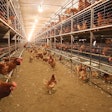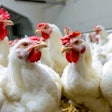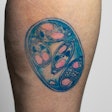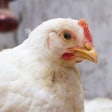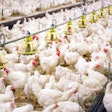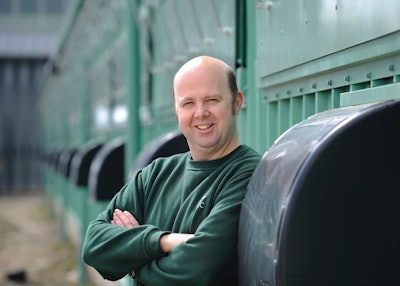
Offering scientifically robust, hypothesis-based trial work in near-commercial conditions all under one roof sets the new state-of-the-art Poultry Science Research Centre in Midlothian, Scotland, U.K., apart from competitors in the rest of Europe.
The GBP5.6 million (US$7.3 million) center, which opened in July, is part of Scotland’s Rural College (SRUC), and has been funded in part by the U.K. AgriTech Centre for Innovation in Excellence in Livestock (CIEL). It is home to work carried out at SRUC’s former Auchincruive site, and its scale and proximity to other centers of excellence in poultry are expected to give it some unique advantages.
Jenny Hone talked to Jos Houdijk, head of SRUC’s Monogastric Science Research Centre about the move into these new facilities.
Hone: What prompted SRUC’s relocation from its former Auchincruive site to the new facility at Midlothian?
Houdijk: SRUC’s relocation of all its poultry research is the result of two elements coming together in a perfect storm.
More than 10 years ago, SRUC put plans in place to sell elements of the 117-acre Auchincruive estate for redevelopment as light commercial or residential space. So some three years ago, it was announced to staff that the site would close and our work relocate to the new center. Alongside this, it was clear the facilities at Auchincruive were becoming increasingly outdated and required significant investment to remain viable, and stay compliant with Home Office regulations.
This new, avian science research center is an important part of SRUC’s vision to become a unique, 21st Century rural enterprise university.
Hone: Is there a strategic benefit to relocating to Midlothian?
Houdijk: Yes, collaboration is the future for all industries, and we are now within shouting distance of two other animal science research providers within the Edinburgh-based Easter Bush Research Consortium – the Roslin Institute, the University of Edinburgh and the Moredun Research Institute.
Within the Roslin Institute, we have potential collaborators on genetics, genomics, novel microbiome methodologies, gene sequencing methodologies, etc., while the Moredun Research Institute is a world leader for research to improve livestock health and welfare through the prevention and control of infectious disease.
It is also interesting to note that CIEL has invested both in a mobile sensory lab that allows research and trial work into product quality based on the sensory attributes such as taste, texture, etc., as well as a mobile CT scanner.
This move will not only create an ethos of closer collaboration between us, but will provide us with closer access to important technologies. Together with the expertise in my own team, it provides a critical mass of animal scientists and resources not found elsewhere in the U.K.
So, in partnership with others, we will have a research capability from egg to drumstick; from farm to fork to plate.
Hone: What are the new site’s key areas of expertise?
Houdijk: The new unit will support current research and expertise in all aspects of poultry production, including nutrition, behavior and welfare – areas where we are particularly strong – as well as health and product quality, with broilers, layers and turkeys.
The unit’s 144 floor pens in one large room can accommodate up to 40 birds per pen – something requested by the industry for the testing of feeds and diets in particular – so, together with a series of small animal rooms and an enriched housing layer facility, we are able to scale up trial work and at the same time mimic what birds experience under more commercial conditions.
In general, farmed birds in research institutes are typically housed under better conditions than the average commercial bird, and this can skew trial results. By contrast, our new unit allows us to mimic conditions that are typical in the industry.
We’re also strong in aspects of broiler quality. For example, we have effective methodologies to look at novel approaches to reduce the risk of Campylobacter transmission. Regulatory studies are another one of our strengths – and I hope we will still want to support both the U.K. Food Standards Agency and European Food Standards Agency requirements following Brexit.

The new Poultry Science Research Centre close to the Easter Bush Research Consortium will create a critical mass of animal scientists. (Colin Hattersley)
Hone: How do SRUC's new state-of-the-art facilities differ from the new state-of-the-art unit at Bristol, which opened in January? They are both part of CIEL.
Houdijk: Both units offer industry-focused research, but the Bristol facility focuses on relatively small-scale, highly controlled layer-type trials, while the strength of our Midlothian center is the ability to run large-scale trials that replicate commercial conditions.
Bristol, for example, is equipped to undertake automatic feed intake and animal weighing research. Feed intake measurements can be taken on an almost continuous basis, so the studies provide a lot of detail. This means certain pilot studies could potentially be conducted at Bristol and then transferred to our Midlothian site for scale up.
We can get close to 5,800 birds for a large-scale trial at Midlothian. At Bristol, you would be looking at ~25% of that. So the two assets work as a continuum, rather than in competition.
CIEL has also co-invested with Newcastle University in C-DIAL (the Centre for Digital Innovation Applied to Livestock) to enable studies using imaging and other kinds of digital methodologies for both pigs as well as poultry. None of these centers replicate each other’s work.
Hone: How many people will be employed at the Midlothian center?
Houdijk: We expect to have between 30-35 people on site once the facility is fully operational by the end of this year/beginning of next. This is a small increase on the 30 staff we had at Auchincruive.
A number of staff are relocating but the new site is 1.5 hours from the old one – too far for a daily commute – so we are now actively recruiting.
Hone: What projects are already underway?
Houdijk: The first project, in partnership with CIEL, is with Gamma Healthcare, trialing some novel antimicrobials for maintaining or improving gut health. Other studies in the pipeline will look at amino acid nutrition for improving gut health. Two industry-funded projects are also under advanced discussion.
Project acquisition is progressing as normal, which gives us confidence that our center is going to deliver.
All the work we undertake is blinded, and with such a large pen broiler unit we can perform one large trial, two trials for the same company, or even two trials for two different companies. Broiler trials are typically completed in five to six weeks, while a layer trial could easily be 20 weeks, if not half a year or longer. So we can have a layer trial running at the same time as a number of broiler trials.
Hone: Who will be your key clients?
Houdijk: While the number of animal feed industry players in the U.K. is not large, there are about 50 key academic and industrial players overall who are already our clients, including some U.K. offices of European and American companies. Our new site affords the type of large-scale trials that have previously not been possible in the U.K., and because we developed this in close consultation with some of the key players in the U.K. industry, we expect them to use the facility they indicated we would need.
Ultimately, I expect a significant component of work will still come from within the U.K., but Brexit and the resulting fall in sterling has made the U.K. a little more competitive for work from outside, and of course a large number of feed companies are international, so from that point of view, the boundaries of U.K. and international are becoming quite vague.
Hone: What other large poultry research facilities is the new center competing with for research funding?
Houdijk: As far as we are aware, there is no direct competition in the U.K. or Europe. No other site can deliver scientifically robust, hypothesis-based trial work under one umbrella, from relatively small scale to near-commercial conditions.
There are some competitors in the U.S., but this is unlikely to result in direct competition, as companies often want to do trial work in Europe as well as America in order to show the benefit of their concepts under different nutritional conditions and climates.
Hone: I understand the distinguished U.S. scientist Norman Lewis is objecting to SRUC’s intended GBP3 million Auchincruive sale on the grounds that, as the land was gifted to the nation for research and education, it can’t be freely sold on the open market. What will SRUC do with the land if it can’t be sold, and how will this affect it financially?
Houdijk: Research estimates our new strategic model could help boost the Scottish economy by GBP4.5 billion. Driving this economic growth includes a proposed GBP35 million investment in our Barony campus in Dumfries, the site of our South & West Faculty. As part of our development of this Faculty, we are continuing to explore options for Auchincruive.






